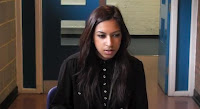Sunday 7 October 2012
Continuity Exercise and Edit Workshop Evaluation
Continuity Editing
We were asked to storyboard, stage and edit a continuity sequence. We worked in groups of 3 but edited individually. The events which occurred in the sequence were given in the brief 'A character opens a door, crosses a room and sits down in a chair opposite another character/characters, with whom he/she then exchanges a couple of lines of dialogue' However as a group we came up with a storyline, based in a police station where two girls were being interrogated after being caught breaking into an office in order to steal files. Coming up with a interesting storyline was an example of our creativity to develop the scenario.
The key skills we were asked to demonstrate was a knowledge and understanding of shot reverse shot, match on action and the 180 degree rule. We also had to include areas of suspense and an interesting variety of settings. We also had to use a interesting range of camera shots and angles, film a wild cat sound track and extra cut aways for smoother editing.
For this project I worked with Rianne Hanooman and Zahra Khan, overall we worked well together as all of our opinions were taken into account and we all had a shared amount of work to do.
Our storyboard was helpful when filming the scenes but not as successful when editing. I changed the order of most of the shots as I felt they didn't fit well together.

We were asked to storyboard, stage and edit a continuity sequence. We worked in groups of 3 but edited individually. The events which occurred in the sequence were given in the brief 'A character opens a door, crosses a room and sits down in a chair opposite another character/characters, with whom he/she then exchanges a couple of lines of dialogue' However as a group we came up with a storyline, based in a police station where two girls were being interrogated after being caught breaking into an office in order to steal files. Coming up with a interesting storyline was an example of our creativity to develop the scenario.
The key skills we were asked to demonstrate was a knowledge and understanding of shot reverse shot, match on action and the 180 degree rule. We also had to include areas of suspense and an interesting variety of settings. We also had to use a interesting range of camera shots and angles, film a wild cat sound track and extra cut aways for smoother editing.
For this project I worked with Rianne Hanooman and Zahra Khan, overall we worked well together as all of our opinions were taken into account and we all had a shared amount of work to do.
Our storyboard was helpful when filming the scenes but not as successful when editing. I changed the order of most of the shots as I felt they didn't fit well together.
Edit Workshop Evaluation
Throughout the production we stuck to the brief including all four main tasks. The 180 degree rule was hard to follow as you could only film from a certain angle and it prevented us from filming some of the shot that were on the story board. During the post production I found that, when filming we broke the 180 degree rule which we had to re-film, However we demonstrated and understanding of the Rule of thirds, Match on action and Shot reverse shot.
Rule of thirds
Shot Reverse Shot
We came across a few challenges during the production stage, as we put all our concentration towards the storyline and lost focus on the main task. If I was to film again I would over film all shots so when editing if there is a mistake I have other shots to fall back on rather than filming the whole shot again, I would also use a bigger range of shot types. I didn't find the post-production as challenging, however if had a chance to edit again I would be sharper with the cuts making the continuity sequence a lot smoother.
The overall creativity was a strength as we had a storyline which created suspense and interest. We included a flashback which told the audience why the characters were in the situation they were in which was also fun to film.
For the setting we used a secluded area adding to the atmosphere and mood of the scene, we also filmed the outside of a police station making it more realistic.
I found the technology simple to use which made the the post production much easier. We filmed many cut aways in order to reduce the jumpiness of the film which worked well as it made it flow better and added to the suspense and tension, it also made editing and putting the shots together less challenging.

Storyboarding was useful during the production however, when editing I changed the order of all the shots as I felt it worked better. My aim was to leave the audience asking questions as to why the two girls were being interrogated and then to reveal at the end why.
There were also many weaknesses, for example we often forgot about the rule of thirds and the 180 degree rule which broke the continuity and wasted time as we had to re-film certain shots. If I could improve, I would use a wider variety of shot types and angles in order to make the scene more interesting. I would also overshoot so I had more shots to choose from when editing.
Subscribe to:
Posts (Atom)












